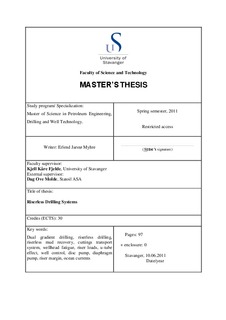| dc.description.abstract | As the oil and gas recoverables are getting more inaccessible and harder to procure, the worlds demand for petroleum resources are constantly increasing. This entails the oil industry to expose themselves towards more challenging environments for oil and gas exploitation. To enable for this development to be beneficial, or even feasible, the industry is eagerly on the lookout for innovative solutions to counter for the given challenge.
This thesis will elucidate a new drilling technique that mitigates narrow pore-/fracture-pressure windows, wellbore instability, depleted formations, formation damage, excessive casing strings, fatigue life, large water depths and hostile environments. The mitigation of fatigue life on the Gullfaks Satellites (GFS) substructure is one of the main drivers for Statoil to implement this technology in the first instance. The technology, called Riserless Drilling Systems, enables for drilling of the entire well without the need of a large rigid riser. The research focus for this thesis will therefore be to evaluate the methods potential, and to see if it is a viable and adaptive solution for the oil and gas industry.
The research methods used for this thesis are an evaluation of the feasibility studies done by the Riserless Drilling System service providers, company visits, data retrieval from relevant sources and some experimental research through the use of the commercial spreadsheet Microsoft Excel. Through careful evaluation of the developing technology, the author is of the opinion that a Riserless Drilling System is a viable solution for the given purpose based on the performed research. The basis for this lies within the already filed proven RMR® technology, and the comprehensive underlying feasibility studies performed. Hence the author concludes, with reservation regarding pump technology, that the conceptual technology will be suitable for the presented water depths. As the water depth on GFS is not of any concern for this technology, it would be a highly potential candidate for the mitigation of further fatigue development on the wellhead systems.
Disregarded the cost involved in utilizing a Riserless Drilling System, the author is of the perception that further initiative is beneficial due to its many positive aspects. As a direct result of these, the technology will emerge and may with time become the best alternative to drill a well in the future. | en_US |
